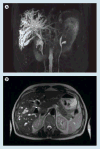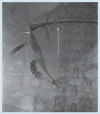Management of perihilar cholangiocarcinoma in the era of multimodal therapy
- PMID: 22928900
- PMCID: PMC3538366
- DOI: 10.1586/egh.12.20
Management of perihilar cholangiocarcinoma in the era of multimodal therapy
Abstract
Perihilar cholangiocarcinoma (CCA) is the second most common primary malignant tumor of the liver. In the USA, there are approximately 3000 cases of CCA diagnosed annually, with approximately 50-70% of these tumors arising at the hilar plate of the biliary tree. Risk factors include advanced age, male gender, primary sclerosing cholangitis, choledochal cysts, cholelithiasis, parasitic infection, inflammatory bowel disease, cirrhosis and chronic pancreatitis. Patients typically present with jaundice, abdominal pain, pruritus and weight loss. The mainstays of treatment include surgery, chemotherapy, radiation therapy and photodynamic therapy. Specific preoperative interventions for patients with perihilar CCA include endoscopic retrograde cholangiopancreatography, percutanteous transhepatic cholangiography and portal vein embolization. Surgical resection offers the only chance for curative therapy in perihilar CCA. R0 resection is of utmost importance and has been linked to improved survival. Major hepatic resection is needed to achieve both longitudinal and radial margins negative for tumor. Fractionated stereotactic body radiotherapy has shown promising results in CCA. Perihilar CCA typically presents with advanced disease, and many patients receive systemic therapy; however, the response to current regimens is limited. Orthotopic liver transplantation offers complete resection of locally advanced tumors in select patient groups.
Conflict of interest statement
The authors have no relevant affiliations or financial involvement with any organization or entity with a financial interest in or financial conflict with the subject matter or materials discussed in the manuscript. This includes employment, consultancies, honoraria, stock ownership or options, expert testimony, grants or patents received or pending, or royalties.
No writing assistance was utilized in the production of this manuscript.
Figures





Similar articles
-
Multimodal treatment strategies for advanced hilar cholangiocarcinoma.Langenbecks Arch Surg. 2014 Aug;399(6):679-92. doi: 10.1007/s00423-014-1219-1. Epub 2014 Jun 25. Langenbecks Arch Surg. 2014. PMID: 24962146 Review.
-
The treatment of cholangiocarcinoma: a hepatologist's perspective.Curr Gastroenterol Rep. 2014 Oct;16(10):412. doi: 10.1007/s11894-014-0412-2. Curr Gastroenterol Rep. 2014. PMID: 25183579 Review.
-
Pathogenesis, diagnosis, and management of cholangiocarcinoma.Gastroenterology. 2013 Dec;145(6):1215-29. doi: 10.1053/j.gastro.2013.10.013. Epub 2013 Oct 15. Gastroenterology. 2013. PMID: 24140396 Free PMC article. Review.
-
Endoscopic management of cholangiocarcinoma.Semin Liver Dis. 2004 May;24(2):165-75. doi: 10.1055/s-2004-828893. Semin Liver Dis. 2004. PMID: 15192789 Review.
-
Three-dimensional computed tomographic cholangiography as a novel diagnostic tool for evaluation of bile duct invasion of perihilar cholangiocarcinoma.Hepatogastroenterology. 2013 Nov-Dec;60(128):1833-8. Hepatogastroenterology. 2013. PMID: 24719915
Cited by
-
Androgen receptor roles in hepatocellular carcinoma, fatty liver, cirrhosis and hepatitis.Endocr Relat Cancer. 2014 May 6;21(3):R165-82. doi: 10.1530/ERC-13-0283. Print 2014 Jun. Endocr Relat Cancer. 2014. PMID: 24424503 Free PMC article. Review.
-
Conditional probability of long-term survival after resection of hilar cholangiocarcinoma.HPB (Oxford). 2016 Jun;18(6):510-7. doi: 10.1016/j.hpb.2016.04.001. Epub 2016 Apr 24. HPB (Oxford). 2016. PMID: 27317955 Free PMC article.
-
Comparison analysis of left-side versus right-side resection in bismuth type III hilar cholangiocarcinoma.Ann Hepatobiliary Pancreat Surg. 2018 Nov;22(4):350-358. doi: 10.14701/ahbps.2018.22.4.350. Epub 2018 Nov 27. Ann Hepatobiliary Pancreat Surg. 2018. PMID: 30588526 Free PMC article.
-
Best options for preoperative biliary drainage in patients with Klatskin tumors.Surg Endosc. 2017 Jan;31(1):422-429. doi: 10.1007/s00464-016-4993-8. Epub 2016 Jun 10. Surg Endosc. 2017. PMID: 27287904
-
Lymphocyte to Monocyte Ratio Predicts Resectability and Early Recurrence of Bismuth-Corlette Type IV Hilar Cholangiocarcinoma.J Gastrointest Surg. 2020 Feb;24(2):330-340. doi: 10.1007/s11605-018-04086-9. Epub 2019 Jan 22. J Gastrointest Surg. 2020. PMID: 30671792 Free PMC article.
References
-
- Altemeier WA, Gall EA, Zinninger MM, Hoxworth PI. Sclerosing carcinoma of the major intrahepatic bile ducts. AMA Arch Surg. 1957;75(3):450–60. discussion 460. - PubMed
-
- Klatskin G. Adenocarcinoma of the hepatic duct at its bifurcation within the porta hepatis an unusual tumor with distinctive clinical and pathological features. Am J Med. 1965;38:241–256. - PubMed
-
- Ito F, Cho CS, Rikkers LF, Weber SM. Hilar cholangiocarcinoma: current management. Ann Surg. 2009;250(2):210–218. - PubMed
Publication types
MeSH terms
Grants and funding
LinkOut - more resources
Full Text Sources
Medical
